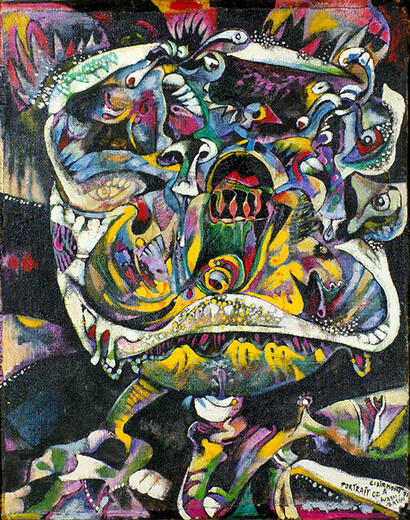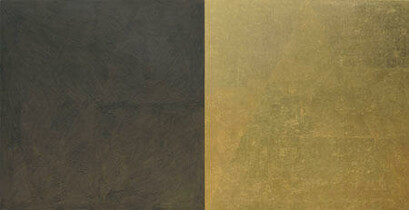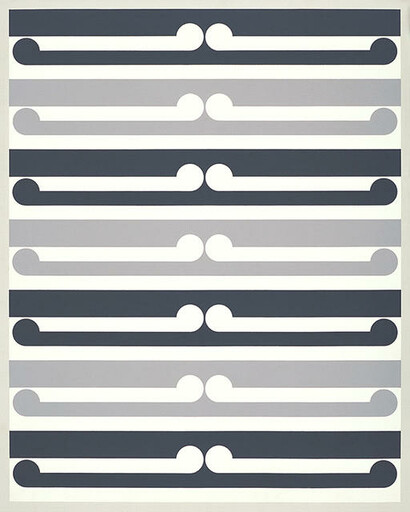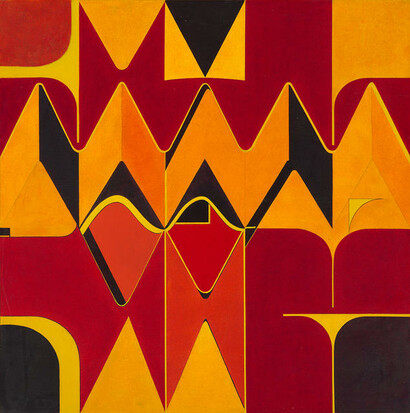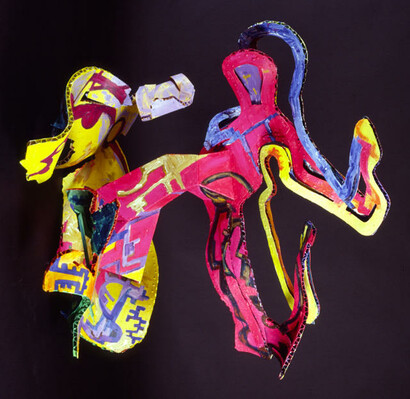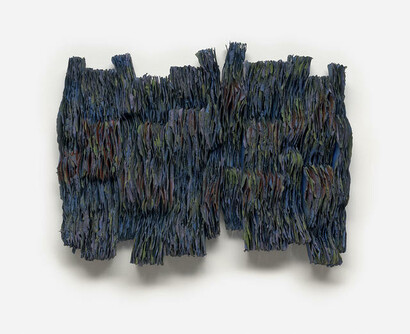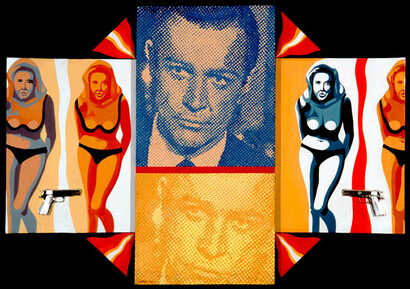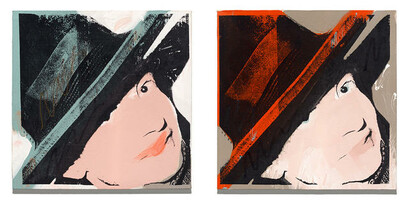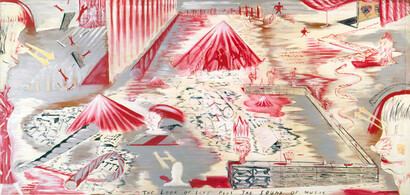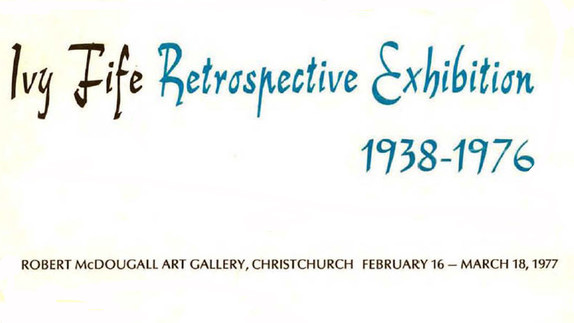This exhibition is now closed
40 out of 40: Canterbury Painters 1958-1998
31 October 1997 –
24 January 1998

John Coley Lone pedestrian Collection of Christchurch Art Gallery Te Puna o Waiwhetū, purchased 1974
Forty works from the permanent collection.
Canterbury has, for most of this century, had a pre-eminence of painting among its art disciplines and this remains true today.
Until the 1950s Canterbury painters were strongly preoccupied with the local landscape as a source of imagery. This emphasis began to shift during the latter years of the decade towards an interest in the prevailing international movements and a positive attempt to foster contemporary art.
In the late 1950s the Art School moved from its old city site to the Ilam campus and a new and influential generation of young artists had begun to emerge. Among them were Pat Hanly, Quentin McFarlane, Ted Bracey, Trevor Moffitt, Alan Pearson, John Coley and Michael Eaton. Among the tutors at this time were William A. Sutton, Ivy Fife, Russell Clark and Colin Lovell Smith, all artists who were reviewing and reassessing the direction of their work in order to renew and revitalise it.
Whilst William A. Sutton and Russell Clark played a significant part in influencing the painting students of the 1950s, it was Rudolf Gopas who was to prove to be the most influential. With ideas grounded in European Expressionism and the modern movement, he made a strong impression on the students of the 1960s who included Tony Fomison, Philip Trusttum and Philip Clairmont. Since the 1950s New Zealand artists had more access to international directions through a variety of media like art magazines, films and travelling exhibitions. A series of New Zealand survey exhibitions which prominently included Canterbury artists were inaugurated by the Auckland City Art Gallery. These promoted and fostered local artists to a wider audience.
In 1959 with the opening of Gallery 91 by the Hungarian-born Andre Brooke, Christchurch gained its first dealer in contemporary art and this initiative was followed in the 1960s by galleries such Labyrinth, The Little Woodware and Several Arts, and by Bosshardts in Akaroa. By the late 1970s these had given way to the Brooke Gifford and 1980s and 1990s to the James Paul, Manawa, Jonathon Jensen, Campbell Grant, Christchurch Artists' Collective and the Centre for Contemporary Art who were all providing opportunities for emerging or established Canterbury painters.
Competitions and government grants provided additional support over the past forty years. In the 1960s Hay's department store sponsored Christchurch's first contemporary art prize and, although the initial awards aroused controversy, it did excite debate in the wider community about contemporary painting. The competition continued until 1966 and had among its Christchurch winners David Graham, Tom Field and Doris Lusk with artists Don Peebles, Quentin MacFarlane and Michael Eaton achieving merit awards.
Travel grants from the Queen Elizabeth Arts Council were also influential from the 1960s. Early recipients being Ted Bullmore, John Coley, Ted Bracey and Alan Pearson. Some of these artists were drawn for a time to the op and pop art styles then internationally current. John Coley, after a visit to the USA in 1964, formed the 20/20 Vision group with several other young Canterbury artists who were students in the late 1950s and early 1960s. In many respects 20/20 Vision helped reinforce the link Canterbury artists had with the contemporary art styles and was a stimulus for future development.
With the 1970s there was a consolidation of attitudes towards contemporary art which was firmly supported by numerous national art awards. The rise of graphic art in particular had its impact on the imagery of the printmakers and painters alike,and the younger artists Jeffery Harris, Bill Hammond, Martin Witworth, Paul Johns, Sam Mahon, Wilhelmus Ruifrock, Michael Armstrong, Kees Bruin and Michael Thomas emerged. The growth of the feminist movement prompted the first of the all women exhibitions adding a new dimension to contemporary art. Partisan tendencies then expanded beyond just gender focus as art became even more politicised in the 1980s and 1990s.
By the late 1970s the nurturing force for contemporary art that The Group had exerted was diminished and in 1977 it ceased. Challenges to traditional values had grown in the 1960s and 1970s and the development in printmaking and sculpture created real competition for the painter.
However in the early 1980s something of a revival occurred as another generation of young artists emerged from the University of Canterbury School of Fine Art to re-establish the pre-eminence of painting in Canterbury art. Among these were Gary Collins, Joanna Braithwaite, Neil Frazer, Bianca van Rangelrooy and Tracy Wilson. In spite of the drift towards post-modernist tendencies on the part of several artists in the late 1980s, the place for painterly values was sustained and in the 1990s the works by such artists as Peter Robinson, Shane Cotton and Séraphine Pick have continued this.
The national financial support agencies for contemporary artists retreated slightly during the 1980s and 1990s but local support from Trust Bank Canterbury with their community grants and the artist-in-residence scheme from 1988–95 has greatly assisted. The establishment in 1987 of the Olivia Spencer Bower Art Award has also advantaged several artists including Pauline Rhodes, Grant Banbury and Linda James.
The last four decades of this century have given rise to many changes in Canterbury painting arising from the 1960s and 1970s which were perhaps the most vital as a period of experimentation when contemporary art values were vigorously challenged, debated and defended.
Since the 1980s more Canterbury painters have attempted to use their work as a voice for environmental, social, gender, racial or personal issues. Such tendencies have led to a real politicising of imagery to serve a function that is essentially beyond the act of painting, more so than in any other period in Canterbury's art history.
This exhibition which comprises works from the Gallery's collection covers a period that has seen the development and maturity of painting in Canterbury to a level that is comparable internationally.
Neil Roberts
This exhibition was held at the Robert McDougall Art Gallery in the Botanic Gardens.
Exhibition number: 650A


